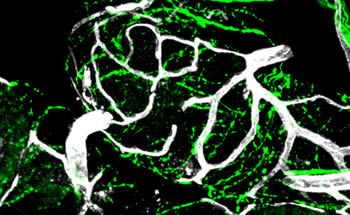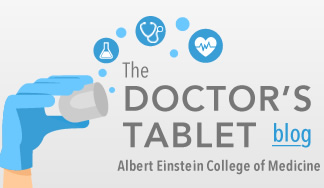
Prostate Cancer Research
Study Shows How Nerves Drive Prostate Cancer
October 19, 2017—(Bronx, NY)—In a study in today’s issue of Science, researchers at Albert Einstein College of Medicine, part of Montefiore, report that certain nerves sustain prostate cancer growth by triggering a switch that causes tumor vessels to proliferate. Their earlier research—which first implicated nerves in fueling prostate cancer—has prompted Montefiore-Einstein to conduct a pilot study testing whether beta blockers (commonly used for treating hypertension) can kill cancer cells in tumors of men diagnosed with prostate cancer.

Paul Frenette, M.D.“Solid tumors depend on an expanding blood supply to thrive,” says study leader Paul Frenette, M.D., professor of medicine and of cell biology and director of the Ruth L. and David S. Gottesman Institute for Stem Cell and Regenerative Medicine Research at Einstein and a member of the NCI-designated Albert Einstein Cancer Center. “Here we show that nerves stimulate the new blood vessels that encourage prostate tumor growth—and that we can short-circuit nerve stimulation to prevent new vessels from forming. This opens up an entirely new strategy for treating prostate cancer—one that we may be able to pursue using existing drugs.”
Prostate cancer is second to skin cancer as the most common cancer in men. The National Cancer Institute estimates that 161,360 new cases of prostate cancer will be diagnosed in 2017, and 26,730 men will die from the disease, accounting for 4.4 percent of all cancer deaths.
In a 2013 paper, also in Science, Dr. Frenette and colleagues showed that nerves play a critical role in helping prostate tumors develop and spread. More specifically, the researchers found that nerves of the sympathetic nervous system (responsible for activating the “fight or flight” response) promote tumor growth by producing norepinephrine, which encourages tumor growth by binding to and stimulating receptors on tumor connective- tissue cells.
In the current study, the researchers used a mouse model of prostate cancer to determine precisely how nerves within connective tissue drive tumor growth. After being released by nerve fibers, norepinephrine binds to receptors on endothelial cells that line the inner surface of blood vessels. The researchers found that the binding of norepinephrine to those receptors triggers an “angio-metabolic switch” that changes how cells metabolize glucose. To make new blood vessels, the endothelial cells—which ordinarily use oxidative phosphorylation to obtain energy from glucose—were now relying almost exclusively on glycolysis. Using glycolysis to metabolize glucose is aphenomenon that had previously been observed in cancer cells.

This image shows tissue from an early-stage tumor developing in a mouse model of prostate cancer. Sympathetic-nerve fibers (green) are closely intertwined with blood vessels (white). Norepinephrine released by nerve fibers stimulates vessel proliferation that fuels tumor growth.To confirm norepinephrine’s role in triggering this metabolic switch, the researchers deleted a gene in their animal model that codes for norepinephrine’s receptor on vessel cells, thereby eliminating norepinephrine’s binding target. They then observed that cells lacking the receptor were using oxidative phosphorylation rather than glycolysis. As a result, the formation of new vessels was inhibited.
“Oxidative phosphorylation generates more energy than glycolysis,” says Dr. Frenette. “It may seem counter-intuitive, but this energy boost provided by oxidative phosphorylation diminishes endothelial cell function and inhibits angiogenesis—the formation of new blood vessels that sustains tumor growth.” In Dr. Frenette’s mouse model of prostate cancer, stimulation from norepinephrine released by nerves had allowed endothelial cells to maintain use of glycolysis, enabling the rapid progression of prostate cancer from a low-grade precancerous stage to a high-grade malignant stage.
“While we need to learn more about the role that norepinephrine-releasing nerves play in prostate cancer, it’s certainly worth exploring whether beta-blockers can improve disease outcomes,” says Dr. Frenette, noting that beta-blockers work by blocking the effects of norepinephrine and similar compounds. Retrospective epidemiological studies, he says, have found that use of these drugs by men with prostate cancer was associated with reduced metastasis and increased survival.
“This opens up an entirely new strategy for treating prostate cancer—one that we may be able to pursue using existing drugs.”
– Paul Frenette, M.D.
The 2017 Science paper is titled “Adrenergic nerves activate an angio-metabolic switch in prostate cancer.” The other Einstein authors are: first author Ali H. Zahalka, an M.D.-Ph.D. student at Einstein; Fumio Nakahara; and Cristian D. Cruz. Additional contributors are Anna Arnal-Estapé, Ph.D., formerly a post-doctoral fellow with Dr. Frenette and now at Yale School of Medicine, New Haven, CT; and Maria Maryanovich, Ph.D., and Lydia W. S. Finley, Ph.D., at Memorial Sloan Kettering Cancer Center, New York, NY.
The study was supported by grants from the National Institutes of Health (HL097700, DK056638, HL069438, F30CA203446, T32 NS007098 and GM007288), the New York Stem Cell Foundation, the EMBO European Commission FP7 (Marie Curie Actions, EMBOCOFUND2012, GA-2012-600394, ALTF 447-2014), and the Japan Society for the Promotion of Science. This work utilized equipment purchased with funding from 1S10OD019961, and P60DK020541. This work has led to a Montefiore-Einstein pilot study, “Beta adrenergic receptor blockade as a novel therapy for patients with adenocarcinoma of the prostate,” led by Benjamin Gartrell, M.D., which can be found on the website ClinicalTrials.gov (NCT02944201).
Other Top Stories
9/11 World Trade Center Exposure Linked to Heart Disease Among NYC Firefighters
On Becoming a Physician: New Einstein Students Receive White Coats and Stethoscopes
Novel Therapy for Acute Migraine Shows Promise in Phase 3 Clinical Trial
First Complete Wiring Diagram of an Animal's Nervous System
Multimillion Dollar NIH Grant to Help Reduce Opioid Use & Get Care to People Who Need It
NIH Grant Funds $23 Million Study of Diseases Affecting People Living with HIV
New TAILORx Data Guides Adjuvant Therapy in Younger Breast Cancer Patients
Einstein Celebrates Its 61st Commencement
Bolstering Biopsies: Testing Patients' Individual Cells to Guide Treatment



